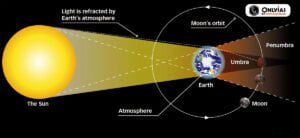Chandra Grahan: Chandra Grahan, or lunar eclipse, has fascinated humans for centuries. This celestial event occurs when the Earth comes directly between the Sun and the Moon, causing the Earth’s shadow to fall on the Moon. While lunar eclipses are relatively common, there are some intriguing aspects and lesser-known facts about Chandra Grahan that might surprise you.
1. Frequency of Lunar Eclipses
Contrary to popular belief, lunar eclipses are not rare occurrences. On average, there are two to four lunar eclipses each year. However, not all of them are total eclipses. Total lunar eclipses, where the Earth’s shadow completely covers the Moon, are less frequent but still happen at least twice a year.

2. Duration of Totality
The duration of a total lunar eclipse can vary. While most total eclipses last for around 1 to 1.5 hours, some can extend to almost 2 hours. The length of totality depends on the position of the Moon in its orbit and the Earth’s shadow size.
3. Blood Moon Phenomenon
During a total lunar eclipse, the Moon often takes on a reddish hue, leading to the term “Blood Moon.” This phenomenon occurs because the Earth’s atmosphere scatters shorter-wavelength blue and green light, allowing longer-wavelength red and orange light to reach the Moon, giving it a reddish tint.
4. Penumbral Lunar Eclipses
In addition to total lunar eclipses, there are penumbral lunar eclipses. In these events, the Moon passes through the Earth’s penumbral shadow, resulting in a subtle shading on the lunar surface. Penumbral eclipses are more challenging to observe as the changes are faint, and they occur more frequently than total eclipses.

5. Safe to Watch
Unlike solar eclipses, lunar eclipses are safe to watch with the naked eye. There is no need for special filters or protective eyewear, making lunar eclipses accessible to everyone. This safety factor adds to the allure of these celestial events.
6. Ancient Cultural Significance
Throughout history, lunar eclipses have held cultural and religious significance in various societies. Some ancient civilizations believed that eclipses were omens or signs of divine intervention. In Hindu mythology, the demon Rahu is said to swallow the Moon during Chandra Grahan, symbolizing the periodic lunar eclipse.
7. Influence on Earth’s Tides
The gravitational pull of the Moon affects Earth’s tides, and during a lunar eclipse, this influence intensifies. The alignment of the Sun, Earth, and Moon creates a straight line, leading to higher gravitational forces. While the difference is not drastic, some coastal areas may experience slightly higher tides during a lunar eclipse.
8. Lunar Eclipses on Other Planets
Lunar eclipses are not exclusive to Earth. Some of the gas giants in our solar system, like Jupiter and Saturn, have moons that can experience eclipses. These events, however, are vastly different from Earth’s lunar eclipses due to the unique characteristics of each planet and its moons.

9. Lunar Reconnaissance Orbiter Observations
Modern technology has allowed us to study lunar eclipses in unprecedented detail. The Lunar Reconnaissance Orbiter (LRO), a NASA spacecraft orbiting the Moon, has captured stunning images and data during lunar eclipses. These observations contribute to our understanding of the Moon’s surface and its interaction with Earth’s shadow.
Chandra Grahan continues to captivate both astronomers and enthusiasts alike. As we delve deeper into the mysteries of our celestial neighbors, these facts shed light on the intricacies of lunar eclipses, enriching our appreciation for these awe-inspiring cosmic events.
WRITTEN BY COLLINS

